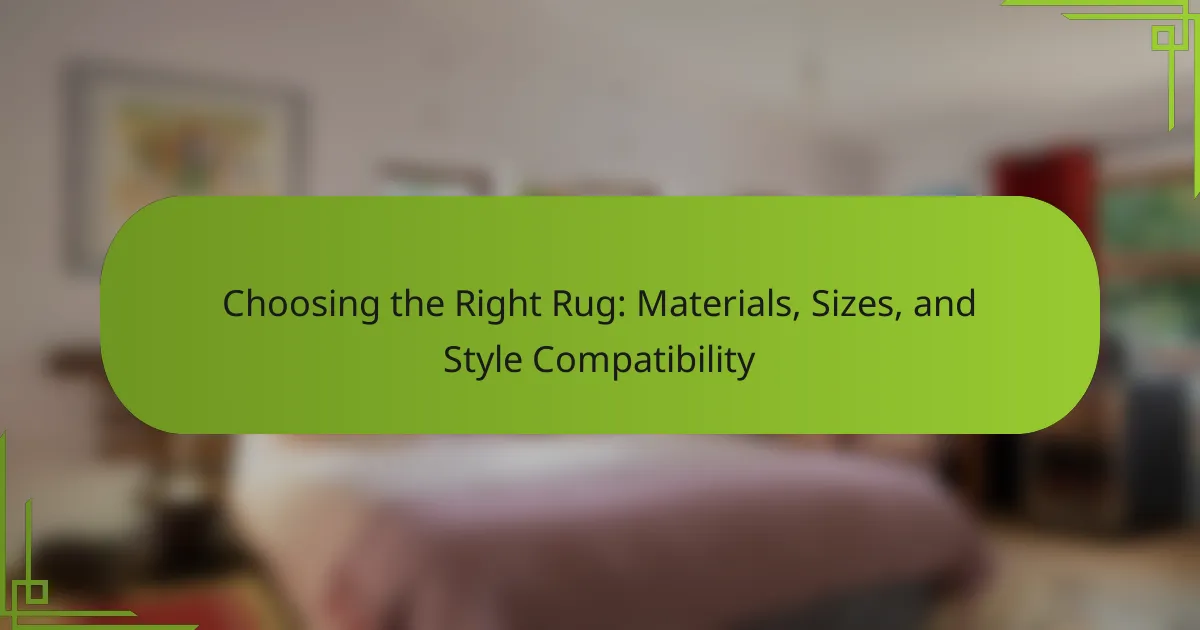
What factors should you consider when choosing a rug?
When choosing a rug, consider size, material, style, and maintenance. Size affects the room’s layout and functionality. Measure the space to ensure a proper fit. Material influences durability and comfort. Common options include wool, synthetic, and cotton. Style should complement existing decor. Choose patterns and colors that enhance the overall aesthetic. Maintenance is crucial for longevity. Some materials require more care than others. For example, wool is durable but may need professional cleaning.
How do different materials impact rug selection?
Different materials significantly impact rug selection by influencing durability, maintenance, comfort, and aesthetics. Natural fibers like wool are durable and provide warmth but require more care. Synthetic materials, such as nylon, are often stain-resistant and easy to clean. Each material offers distinct textures and appearances, affecting the overall style of the space. For instance, silk rugs are luxurious but less durable, making them suitable for low-traffic areas. Additionally, the choice of material can affect the rug’s price point, with natural fibers typically costing more. Understanding these differences helps consumers make informed decisions that align with their lifestyle and design preferences.
What are the common materials used in rugs?
Common materials used in rugs include wool, cotton, jute, and synthetic fibers. Wool is known for its durability and natural stain resistance. Cotton offers softness and is easy to clean. Jute is a sustainable option, valued for its eco-friendliness and texture. Synthetic fibers, such as nylon and polyester, are often used for their affordability and resistance to wear. These materials are frequently chosen based on their specific attributes, making them popular in various rug styles.
How does the durability of materials affect rug longevity?
Durability of materials directly influences rug longevity. High-durability materials, such as wool and nylon, resist wear and tear better than low-durability options like cotton. This resistance to damage extends the lifespan of the rug. For instance, wool rugs can last over 20 years with proper care. In contrast, cotton rugs may only last 5 to 10 years. The ability to withstand foot traffic and cleaning also contributes to longevity. Rugs made from durable materials maintain their appearance and structural integrity longer. Therefore, choosing durable materials is essential for long-lasting rugs.
What sizes of rugs are available and how do they fit into spaces?
Rugs are available in various sizes, including small (2×3 feet), medium (5×8 feet), large (8×10 feet), and extra-large (9×12 feet or larger). Small rugs fit well in entryways or beside beds. Medium rugs are suitable for smaller living areas or under coffee tables. Large rugs work best in spacious living rooms or dining areas, anchoring furniture. Extra-large rugs are ideal for open floor plans, providing a cohesive look. The size of the rug should complement the dimensions of the room and the arrangement of furniture to enhance visual appeal and functionality.
What standard rug sizes should you know about?
Standard rug sizes include 2×3 feet, 3×5 feet, 4×6 feet, 5×8 feet, 6×9 feet, 8×10 feet, and 9×12 feet. These dimensions cater to various room layouts and furniture arrangements. For example, a 5×8 feet rug is suitable for a small living area. An 8×10 feet rug works well under a dining table. The 9×12 feet size is ideal for larger spaces, accommodating multiple furniture pieces. Knowing these sizes helps in selecting the right rug for your space.
How do you measure a space to choose the right rug size?
To measure a space for choosing the right rug size, first determine the dimensions of the area. Use a measuring tape to find the length and width of the space. Measure from wall to wall or between furniture pieces. Consider leaving a border of floor visible around the rug. A common guideline is to leave at least 18 inches of floor space. This ensures the rug fits well within the room’s design. For larger rooms, rugs can be centered under furniture. For smaller spaces, a rug should fit under the front legs of furniture. This creates a cohesive look. Ultimately, the right size enhances the room’s aesthetic and functionality.
How does style compatibility influence your rug choice?
Style compatibility significantly influences rug choice by ensuring that the rug complements the overall decor. A well-matched rug enhances the aesthetic appeal of a room. It can unify different design elements and create a cohesive look. For example, a modern rug may clash with traditional furnishings, disrupting the visual harmony. Conversely, a rug that aligns with the room’s style can elevate the space. Studies show that color and pattern compatibility affects perceived room size and comfort. A suitable rug also contributes to the functionality of the space, such as providing warmth in a minimalist setting. Ultimately, considering style compatibility helps in making informed and visually pleasing choices.
What design styles are popular for rugs?
Popular design styles for rugs include modern, traditional, bohemian, and contemporary. Modern rugs often feature geometric patterns and bold colors. Traditional rugs typically showcase intricate designs and rich color palettes. Bohemian rugs are known for their eclectic mix of colors and textures. Contemporary rugs often blend various styles and are characterized by minimalistic designs. Each style caters to different aesthetic preferences and complements various interior designs.
How can you match a rug to your existing decor?
To match a rug to your existing decor, consider the color palette of your room. Choose a rug that complements or contrasts with the dominant colors in your decor. For example, if your decor features warm tones, select a rug with similar hues or a contrasting cool color for balance. Next, evaluate the patterns in your decor. A patterned rug can enhance visual interest if your existing decor is mostly solid. Conversely, a solid rug can provide a calming effect in a space filled with patterns. Additionally, consider the rug’s texture. A plush rug can add warmth to a minimalist space, while a flatweave can suit a more modern aesthetic. The size of the rug is also crucial; it should fit the layout of your furniture. Ideally, the front legs of your furniture should rest on the rug to create a cohesive look. Finally, ensure that the style of the rug aligns with your overall decor theme, whether it’s contemporary, traditional, or eclectic.

What are the benefits of selecting the right rug?
Selecting the right rug enhances both aesthetics and functionality in a space. A well-chosen rug can unify a room’s decor, creating a cohesive look. It also provides comfort underfoot, adding warmth to cold floors. Additionally, the right rug can improve acoustics by absorbing sound. Choosing the correct size prevents a cramped or disproportionate appearance. Furthermore, suitable materials can increase durability and ease of maintenance. For example, wool rugs are known for their resilience and stain resistance. Overall, selecting the right rug contributes significantly to a room’s ambiance and practicality.
How does a well-chosen rug enhance a room’s aesthetic?
A well-chosen rug enhances a room’s aesthetic by adding color, texture, and warmth. It serves as a focal point that ties together various design elements. A rug can define spaces, especially in open floor plans. The right rug complements furniture and decor, creating harmony. Additionally, it can influence the perceived size of a room. For example, a large rug can make a space feel more expansive. Studies show that rugs can improve acoustic comfort by absorbing sound. Overall, a well-selected rug is essential for cohesive interior design.
What visual effects can rugs create in a space?
Rugs can create various visual effects in a space. They can define areas within a room, such as separating a living area from a dining space. Rugs also add warmth and texture, enhancing the overall comfort of a room. A well-chosen rug can serve as a focal point, drawing attention and adding character. Additionally, rugs can influence the perceived size of a space; lighter colors can make a room feel larger, while darker shades can create a cozy atmosphere. Patterns and designs on rugs can add depth and interest, complementing existing decor. Overall, rugs play a significant role in shaping the visual dynamics of interior spaces.
How do rugs contribute to the overall comfort of a room?
Rugs contribute to the overall comfort of a room by providing warmth and cushioning underfoot. They help to insulate the floor, reducing coldness, especially in winter months. Rugs also absorb sound, which minimizes noise levels and enhances a room’s tranquility. Additionally, they create a defined space, making areas feel cozier and more inviting. The texture of a rug can add tactile comfort, encouraging relaxation. Studies show that rooms with rugs can feel more comfortable and inviting, influencing mood positively. Overall, rugs serve both functional and aesthetic purposes, enhancing comfort significantly.
What practical advantages come from the right rug material?
The right rug material offers durability, comfort, and ease of maintenance. Durable materials like nylon and polypropylene withstand heavy foot traffic. This longevity reduces the need for frequent replacements. Comfortable materials, such as wool, provide warmth and softness underfoot. Easy-to-clean options like polyester make maintenance simpler for spills and stains. These factors contribute to a rug’s overall functionality in various environments.
How do different materials affect maintenance and cleaning?
Different materials significantly influence maintenance and cleaning. Natural fibers like wool require regular vacuuming and occasional professional cleaning. Synthetic fibers, such as nylon or polyester, are easier to clean and often stain-resistant.
Materials like cotton can be machine-washed but may shrink over time. Silk rugs demand gentle care and should be cleaned by specialists to avoid damage.
The durability of materials also affects maintenance frequency; tougher materials need less upkeep. For example, polypropylene is highly resistant to stains and fading, making it low-maintenance.
In contrast, delicate materials like silk necessitate more careful handling and cleaning methods. Understanding these differences helps in choosing the right rug for specific cleaning needs.
What are the environmental impacts of various rug materials?
Different rug materials have varying environmental impacts. Natural fibers like wool and cotton are biodegradable and renewable. They typically have a lower carbon footprint compared to synthetic materials. Wool production can lead to land degradation if not managed sustainably. Cotton farming often requires significant water and pesticide use, impacting ecosystems.
Synthetic materials such as nylon and polyester are derived from petroleum. Their production involves fossil fuel extraction, contributing to greenhouse gas emissions. These materials are non-biodegradable and can persist in landfills for hundreds of years. Additionally, synthetic rugs may release volatile organic compounds (VOCs), affecting indoor air quality.
Recycled materials, like PET from plastic bottles, offer a more sustainable option. They reduce waste and the need for new resources. However, the recycling process itself can consume energy and produce emissions.
Overall, the choice of rug material significantly influences environmental sustainability. Selecting natural or recycled options generally results in less environmental harm.

What are the common mistakes to avoid when choosing a rug?
Common mistakes to avoid when choosing a rug include selecting the wrong size. A rug that is too small can make a room feel disjointed. Conversely, an oversized rug can overwhelm the space. Another mistake is ignoring the material. Different materials have varying durability and maintenance needs. For example, wool rugs are durable but can be more expensive. Additionally, failing to consider the room’s function can lead to issues. Rugs in high-traffic areas should be more resilient. Not coordinating the rug’s style with existing decor is another frequent error. The rug should complement the room’s overall aesthetic. Lastly, neglecting to test the rug in the space can result in dissatisfaction. Always visualize the rug in the intended area before purchase.
How can poor sizing choices affect a room?
Poor sizing choices can significantly impact a room’s functionality and aesthetics. If a rug is too small, it can make the space feel disjointed. A small rug may leave furniture partially off the mat, creating an unbalanced look. Conversely, an oversized rug can overwhelm a room. It may obscure flooring and disrupt the visual flow. Proper sizing helps define areas, especially in open floor plans. According to interior design principles, a well-sized rug should anchor furniture and create a cohesive look. A rug that fits well enhances comfort and style, contributing to the overall ambiance of the room.
What are the signs of an ill-fitting rug?
An ill-fitting rug shows several signs. First, it may not align with the furniture layout. For example, furniture legs might sit awkwardly on or off the rug. Second, the rug could be too small, leaving bare floor exposed around the edges. This can disrupt the visual flow of the room. Third, an ill-fitting rug can bunch up or wrinkle, creating tripping hazards. Additionally, the rug may slide or shift easily, indicating it lacks proper grip. Lastly, color and pattern mismatch can also signal an ill fit with the room’s overall aesthetic. These signs help in identifying a rug that does not complement the space effectively.
How do you avoid overwhelming a small space with a large rug?
To avoid overwhelming a small space with a large rug, choose a rug that complements the room’s dimensions. Select a rug that has a lighter color or pattern to create an illusion of space. Position the rug to allow some floor visibility around its edges. This visibility helps maintain balance in the room. Use furniture to anchor the rug, placing key pieces partially on it. This technique integrates the rug into the overall design. Additionally, consider a rug with a simple design to prevent visual clutter. These strategies collectively enhance the space without making it feel cramped.
What should you keep in mind about rug maintenance?
Regular vacuuming is essential for rug maintenance. It removes dirt and debris that can damage fibers. Use a vacuum without a beater bar for delicate rugs. Spot clean stains immediately to prevent permanent damage. Use a mild detergent and water for cleaning. Professional cleaning is recommended every 1-3 years. Rotate rugs periodically to ensure even wear. Protect rugs from direct sunlight to prevent fading.
How does the material influence cleaning methods?
The material of a rug significantly influences the cleaning methods used. Different materials have varying levels of durability, absorbency, and stain resistance. For instance, wool rugs are known for their resilience but require gentle cleaning methods to avoid damage. Synthetic fibers, such as nylon, are often more stain-resistant and can withstand harsher cleaning agents. Natural fibers like jute are more susceptible to moisture and may require dry cleaning to prevent mold growth. Additionally, the cleaning frequency is affected by the material; high-traffic areas with synthetic rugs may need more frequent cleaning compared to delicate silk rugs. The choice of cleaning products also depends on the material; some materials can be damaged by certain chemicals. Understanding the specific attributes of the rug material is essential for selecting appropriate cleaning methods.
What are the best practices for maintaining the appearance of your rug?
Regular vacuuming is essential for maintaining the appearance of your rug. It removes dirt and debris that can cause wear. Vacuum at least once a week, more often in high-traffic areas. Spot clean stains immediately with a mild detergent. Blot the area gently with a clean cloth to avoid spreading. Rotate your rug every six months to ensure even wear. This practice helps maintain its shape and color. Avoid direct sunlight to prevent fading. Use curtains or blinds to protect your rug from UV rays. Professional cleaning is recommended every 1-3 years. This deep cleaning removes embedded dirt and allergens. Following these practices can significantly extend the life and appearance of your rug.
What tips can help you choose the perfect rug for your needs?
To choose the perfect rug for your needs, consider the room’s size and layout. Measure the space to ensure the rug fits appropriately. Select a material that suits your lifestyle; for instance, wool is durable and soft, while synthetic fibers are easy to clean. Think about the rug’s style and color to complement existing decor. Choose a design that enhances the room’s aesthetic. Additionally, consider the rug’s pile height; low pile is easier to clean, while high pile offers comfort. Assess the rug’s durability based on foot traffic in the area. Finally, set a budget that aligns with your preferences and requirements.
How can you effectively combine different rug styles in one space?
To effectively combine different rug styles in one space, select a common color palette. This unifies the diverse patterns and textures. Use varying shapes and sizes for visual interest. Layer rugs for depth and dimension. Ensure the rugs complement each other in style, such as mixing modern with traditional. Place larger rugs beneath smaller ones to anchor the arrangement. Balance bold patterns with solid colors to avoid overwhelming the space. Utilize rugs to define areas within an open layout. This method enhances cohesion while showcasing individual styles.
What resources are available for finding the right rug for your home?
Online retailers offer a wide selection of rugs for home decor. Websites like Wayfair, Overstock, and Amazon provide filters for size, color, and material. Interior design blogs often feature guides on selecting rugs that match specific styles. Pinterest serves as a visual resource for inspiration and design ideas. Home improvement stores like Home Depot and Lowe’s allow customers to see rugs in person. Local carpet shops provide personalized assistance and a variety of options. Social media platforms can connect users with rug trends and reviews. Online marketplaces like Etsy showcase handmade and unique rug options.
Choosing the Right Rug is the primary entity of this article, which provides essential guidance on selecting rugs based on materials, sizes, and style compatibility. Key factors include understanding the impact of different materials on durability and maintenance, as well as recognizing the significance of rug size in relation to room layout and furniture arrangement. The article also emphasizes the importance of style compatibility to enhance the overall aesthetic of a space. Common mistakes to avoid, maintenance tips, and resources for finding the ideal rug are discussed to assist consumers in making informed decisions.
